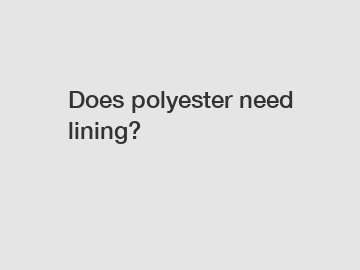Does polyester need lining?
With competitive price and timely delivery, SHUOLAN sincerely hope to be your supplier and partner.
When it comes to clothing materials, polyester has managed to gain a reputation that is both loved and loathed. It is known for its versatility, durability, and affordability. However, there is often confusion surrounding whether polyester garments require lining. In this blog post, we will explore the commonly debated question: "Does polyester need lining?" We'll separate fact from fiction and help you understand when and why lining might be necessary.
Understanding Polyester:

Polyester is a synthetic fabric made from petroleum-based products. It gained popularity in the fashion industry due to its ability to mimic natural fibers like silk and cotton while offering enhanced durability. Polyester is known for its water resistance, wrinkle-free properties, and resistance to stretching, shrinking, and fading. These characteristics make it a favorite choice for a wide range of clothing items.
Debunking the Myth:
Contrary to popular belief, polyester does not always need lining. Whether to line a garment or not depends on various factors such as the type of polyester fabric, the style of the garment, and the wearer's specific comfort and aesthetic preferences. Let's delve into these factors to gain a better understanding.
1. Type of Polyester Fabric:
Polyester comes in various forms, from lightweight and sheer chiffon to thicker and heavier options. The decision to line a polyester garment largely depends on the fabric's transparency, clinginess, and breathability. For example, lightweight and sheer polyester fabrics like chiffon or organza often benefit from lining to add structure, modesty, and to prevent see-through issues. Meanwhile, thicker polyester fabrics with different textures, such as brocade or jacquard, may not require lining due to their inherent weight and opacity.
2. Style and Construction of the Garment:
The style and construction of the garment play a significant role in determining whether lining is necessary. Some polyester garments, such as flowy maxi dresses or skirts, can benefit from lining to reduce static cling, offer additional comfort, and improve the drape of the fabric. Tailored polyester garments like blazers or trousers often come with built-in linings to provide structure, enhance durability, and prevent the fabric from clinging to the body.
3. Comfort and Aesthetics:
Comfort and aesthetics are highly subjective factors that influence the decision to add lining. While some individuals may prefer the smooth and cool feel of a lining against their skin, others might find it too restrictive or unnecessarily warm. Ultimately, it depends on personal preference and the intended purpose of the garment.
When Lining is Beneficial:
While polyester garments don't always require lining, there are scenarios where the addition of lining can be advantageous:
1. Modesty and Coverage: Sheer, lightweight polyester fabrics like chiffon or organza can be prone to show-through. Lining such fabrics ensures modesty and prevents any embarrassing wardrobe malfunctions.
2. Structural Support: Polyester fabrics that lack natural firmness or structure, particularly when used in tailored garments, can benefit from lining. It enhances the garment's shape, hides seams, and provides an overall sleek finish.
3. Reducing Clinginess: Polyester is known to generate static electricity, which causes garments to cling to the body. A lining made from an anti-static material can help reduce clinginess, making the garment more comfortable to wear.
4. Comfort and Longevity: For individuals with sensitive skin, a lining can provide a protective barrier that prevents direct contact with the polyester fabric, reducing potential discomfort. Additionally, lining can extend the lifespan of a garment by reducing abrasion against the body and protecting the fabric against perspiration.
Conclusion:
In summary, whether or not polyester requires lining depends on several factors such as fabric type, garment style, and personal preferences. Polyester garments with lightweight or sheer fabrics often benefit from lining, providing structure, modesty, and comfort. However, it is not always necessary for all polyester garments. Ultimately, the decision to add lining rests with the wearer's comfort, aesthetic preferences, and the desired purpose of the garment.
Remember, fashion is versatile, and there are no hard and fast rules. Experimentation and individual preferences should guide your decision to line or not to line your polyester garments.
Please visit our website for more information on this topic.
Are you interested in learning more about tc cotton fabric? Contact us today to secure an expert consultation!



